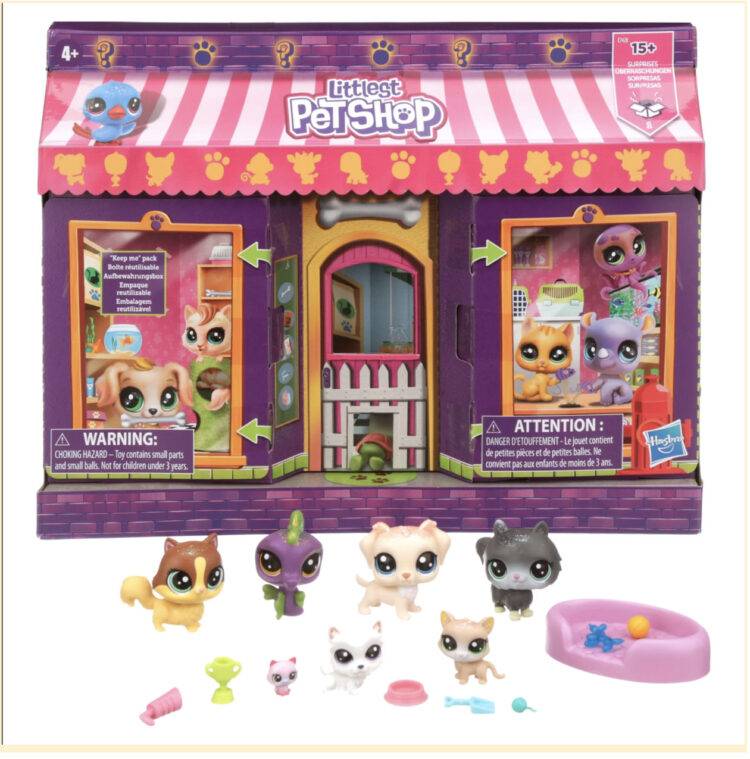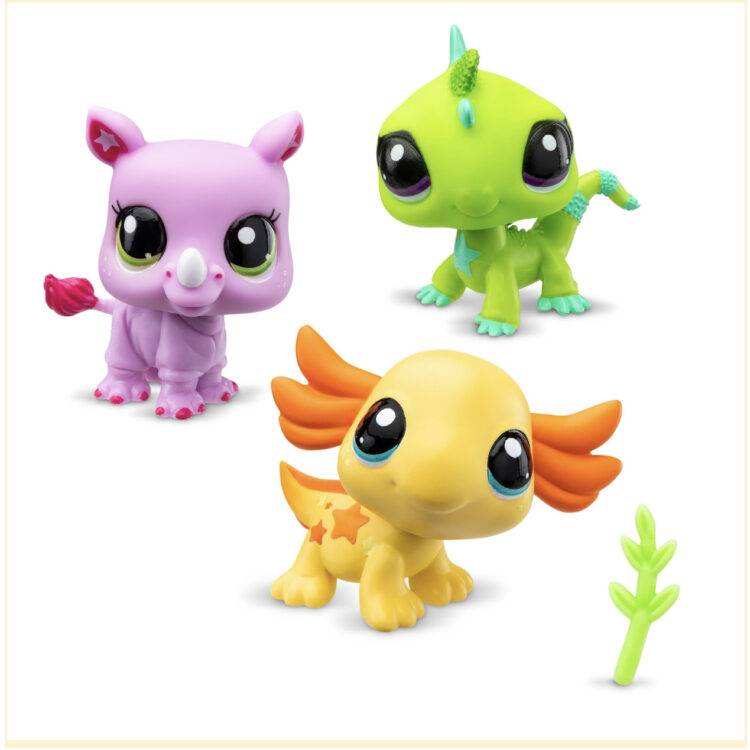
Never before has there been a comprehensive timeline of the many different redesigns of the brand, until now.
Part of what makes this brand so unique is the number of reboots it’s enjoyed. Littlest Pet Shops —referred to here as LPS— is loosely defined by generations. Until the most recent release, the generations of LPS were fan-defined. They were determined by the numbers given to the pets. A new generation was determined by fans when the number of pets was reset to zero. The seventh generation launched in 2022.
LPS figurines were first produced in 1992 by Kenner Toys. The original line stylized pets that each came in a themed home and performed an action. Some pets moved magnetically, were stamps, or had a moving part that made them interactive.
Kenner LPS toys originated the brand and are the most distinct. While elements of the line continued on (like the magnetic interactive features), the proportional-yet-stylized shop-centered toy line ceased in 1997, never to return.
But the whimsy and charm of LPS has lived on.
In the year 2000, Kenner was completely absorbed into Hasbro and multiple toy lines were either completely shut down or reimagined, including LPS.
The second generation spanned 2005 to 2012 and included multiple redesigns. Starting with what is referred to as Generation 2.1 by fans, the 2005 to 2007 iteration of the line was the first to feature the now-signature bobbleheads. These were less shop-based and would be the basis of a majority of the online community and fandom.
In 2009, the pets lost their magnets in favor of holes and pegs in the playsets and accessories, allowing for customization.
In 2010, Blythe (a Kenner-produced doll from 1972) was reintroduced via an LPS line called “Blythe Loves Littlest Pet Shop,” with a number of sets that featured both LPS pets and smaller Blythe dolls.
The rise of social media and online communities in the early 2000s gave LPS fans a home from where they can connect with each other over YouTube and other platforms.
“Littlest Pet Shop: Popular,” @SophieGTV’s LPS YouTube series put out its first episode in 2011. While it wasn’t the first LPS fan-made web series, it (appropriately) became the most popular, boasting over 4 million views and an online fan community of its own. It became emblematic of the online community. The videos were narrative stories that read more like filmed extensions of imaginative play and often followed darker themes.
“I liked collecting them as a child because I watched LPS YouTube, and also because I was obsessed with animals, and I wasn’t allowed to get a pet,” said SAIC student Spencer Creighton (BFA 2027).
Generation 3 (2012 to 2014) was centered around a new television show with Blythe as the lead character. The pets now had names and storylines that aligned with the show. This generation also saw the end of the bobbleheads. Generation 4 (2014 to 2016) brought them back and added small holes and deco bits to customize pets. Generation 5 was essentially the same as 4.
In 2017, a new television show, “Littlest Pet Shop: A World of Our Own,” launched Generation 6, sans Blythe, and redesigned the pets to rely on gimmicks. It struggled to remain profitable with the decline of the brand and the closure of toy stores like Toys R Us.
Finally, Generation 7 was announced in 2022 and first revealed in 2023. The line was rebooted by BasicFun, a nostalgia-centric toy production company, that purchased the rights to rerelease the brand. As of 2024, they are now on shelves at places like Macy’s and Target.
As a part of the newly released line, a tie-in with Roblox was announced; however, the tie-in was marketed through the toys as a virtual experience and was only explicitly referred to as a Roblox experience on the LPS website.
Generation 7 pets are most similar to the Generation 2 pets and include bright flashy colors with pictorial symbols and bobbleheads. It consists mostly of pets from reused molds. In fact, many of the new pets have Hasbro’s old copyright stamps on them.
BasicFun sent a number of adult LPS content creators PR packages. The move to focus on nostalgia was not unfounded, the LPS community mostly consists of adult collectors who enjoyed the brand as children. However, the brand still markets to children as well, as seen by the Roblox tie-in and TV ads.
Generation 7 has now become the easiest to collect of all the LPS generations because of its availability both online and in toy sections. The newest generation pets individually retail for $3.99, or more if they’re sets.
All other LPS generations are only available through second-hand retailers, like eBay or thrift stores, and are much more difficult to collect. Generation 1 is the most expensive. Being 32 years old, and consisting of sets with many small pieces, collecting one complete Generation 1 set can cost upwards of $50. Generation 2 is the most popular to collect due to its prominence in the LPS community.
“I’ve always really adored animals so I gravitate more towards Littlest Pet Shop more than any other doll-esque toy. While I haven’t been recently collecting them because I thought they were still in their weird ultra-cutesy phase (which is the time I stopped looking because I did not like that style) I’m glad to see they’ve gone back to their original style,” said SAIC student Hannah Ji (BFAW 2024).
The future of LPS is in its past, as the new line of the brand is entirely based on nostalgia.
















